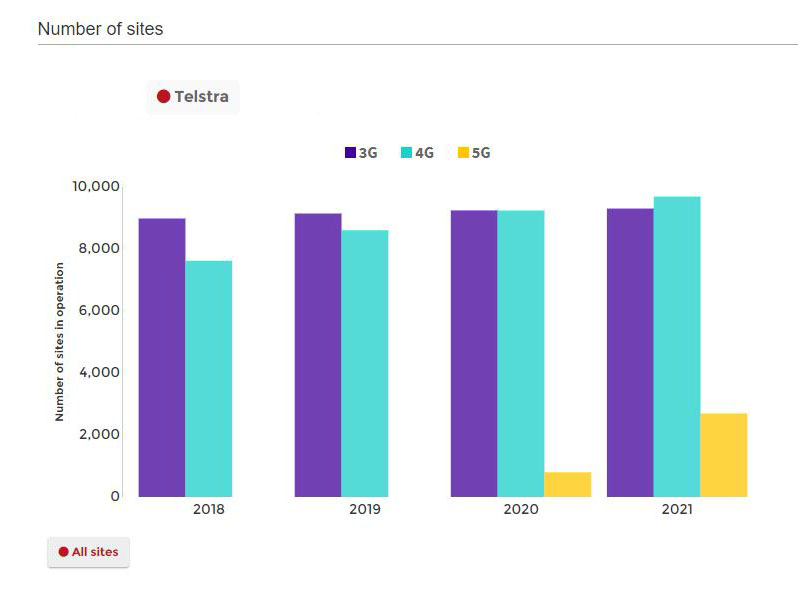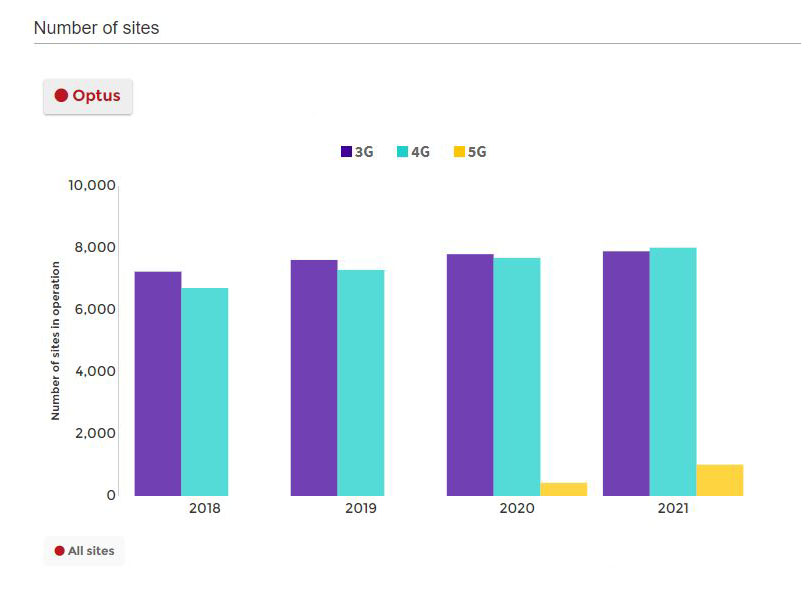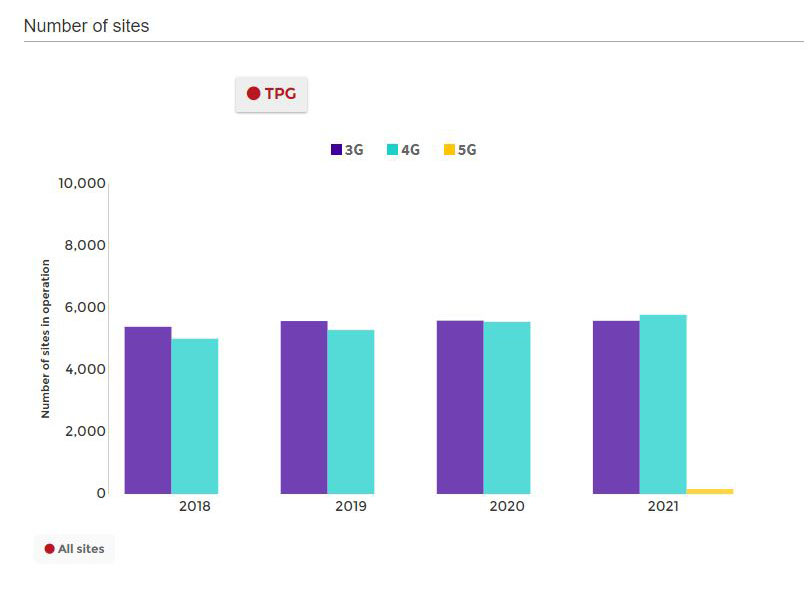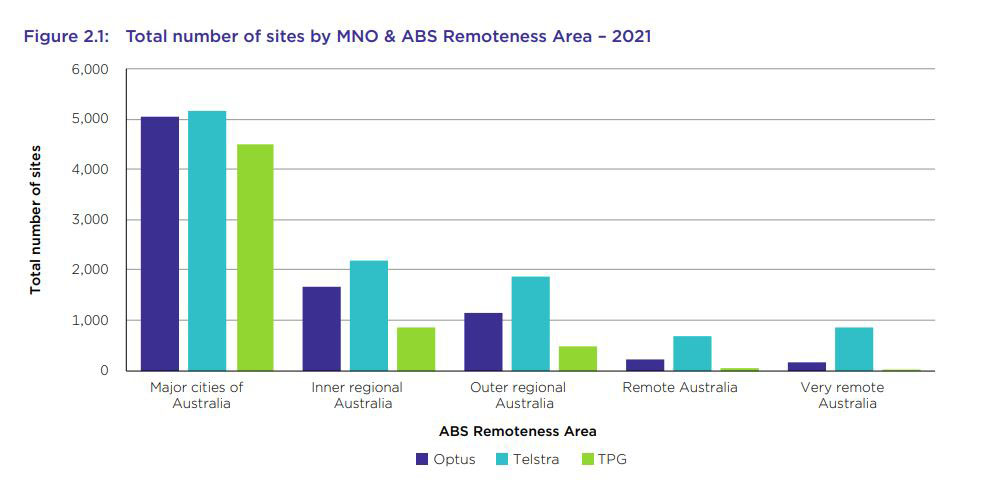Consumer watchdog The Australian Competition and Consumer Commission (ACCC) has released an all-new paper that finally gives customers a clearer picture of how the big three telcos compare on mobile network coverage. The ACCC’s Mobile Infrastructure Report 2021 breaks down Telstra, Vodafone (TPG Telecom) and Optus’ mobile network development from 2018 to 2021, offering insights into each telco’s 5G rollout as well as a snapshot of overall 3G, 4G and 5G coverage nationwide.
Unsurprisingly, it’s the biggest provider dominating the 5G rollout race, with Telstra owning both the largest number of 5G sites and the most mobile sites overall, regardless of technology type. Telstra deployed 407 new mobile sites in 2021, and now boasts 2,695 5G sites across the country – that’s more than twice as many 5G sites as Optus (with 1,010), and roughly sixteen times as many as Vodafone/TPG (with 163).
Telstra mobile sites
According to the ACCC’s data, Telstra’s mobile sites consist of the following:
- Total sites: 10,766 (up 3% since 2020)
- 3G sites: 9,305
- 4G sites: 9,691
- 5G sites: 2,695
Telstra rolled out 407 new mobile sites in 2021, again more than Optus or Vodafone, but 28.3% of these were co-funded. Co-funded sites have been partly funded by government co-contribution programs, such as the Federal Government’s Mobile Black Spot Program. The Black Spot Program accounted for the majority of co-funded sites owned by Telstra, and is reflected in the telco’s wider coverage in regional areas when compared to Optus and Vodafone.

Optus mobile sites
In second place for site totals is Optus, with following sites as of 2021:
- Total sites: 8,238 (up 3.2% since 2020)
- 3G sites: 7,893
- 4G sites: 8,011
- 5G sites: 1,010
The ACCC’s data shows that Optus launched 337 new sites this year, with 5.6% of those being co-funded. In terms of 5G, Optus is still lagging behind Telstra, but has doubled its number of 5G sites in the last 12 months.

Vodafone (TPG Telecom) mobile sites
- Total sites: 5,892 (up 3.8% since 2020)
- 3G sites: 5,587
- 4G sites: 5,781
- 5G sites: 163
TPG Telecom – which now operates the Vodafone mobile network, after the two companies merged in 2020 – deployed 261 new sites in 2021, none of which were co-funded. The telco has just over half the number of total mobile sites as Telstra, and only 163 5G sites as of this year; however, the merger process and decision to scrap the formerly-proposed TPG network in 2018, due to losing Huawei as a vendor, likely contributed to the slower 5G roll out. Despite being noticeably behind, TPG Telecom is making a concerted effort to catch up, and last month tripled its 5G coverage with the launch of its 5G standalone core.

Coverage compared: cities, regional and rural Australia
TPG and Vodafone’s total mobile coverage in major cities is comparable to that of Telstra and Optus, but does fall behind in regional and remote areas, as shown below. Thanks to initiatives such as the Mobile Black Spot Program, Telstra offers by far the widest network coverage in regional, remote and very remote areas of Australia; as of 2021, Telstra operates 5,601 sites outside major cities, compared to 3,201 from Optus and 1,389 from TPG/Vodafone.

Coverage clarity a focus for ACCC
While each telco offers online coverage maps for 3G, 4G, and 5G services, these are based on predicted coverage; although you might be covered on paper, your real-world mobile reception could vary. This is especially true of 5G, which is still in the rollout phase and can be impacted by geographic factors, and even whether you’re indoors or outdoors.
Coverage maps outline a footprint, and are indicative only. So it can be difficult for customers to determine how strong a network’s mobile coverage actually is, especially if you’re living outside a major city. The ACCC is working to help make coverage more transparent for Australians, with this month’s Mobile Infrastructure Report being a major first step.
“We know many consumers in regional areas find it difficult to check what coverage is available in their area. Our own analysis shows that assessing geographic coverage with the network operators’ maps is difficult,” said ACCC Commissioner Anna Brakey.
“Comparable and accurate coverage information is important for all consumers in making informed choices about their mobile providers, but it is particularly critical for the safety of regional and remote communities.”
The ACCC intends to use the data from its ongoing reports to provide transparency on the infrastructure operated by each of the big three networks, and to hold telcos accountable for network investment claims. With 5G phone and internet now a major ongoing focus for Telstra, Optus and TPG/Vodafone, hard data on available mobile sites could be a helpful tool for keeping track of each provider’s network rollout.
Compare Telstra, Optus and Vodafone mobile plans
The following table shows selected published Optus SIM-only postpaid plans on Canstar Blue’s database, listed in order of cost, from the lowest to highest and then by data allowance, largest to smallest. Use our comparison tool to see plans from a range of other providers. This is a selection of products with links to a referral partner.
The following table shows selected published Telstra SIM-only postpaid plans on Canstar Blue’s database, listed in order of cost, from the lowest to highest and then by data allowance, largest to smallest. Use our comparison tool to see plans from a range of other providers. This is a selection of products with links to a referral partner.
The following table shows selected published Vodafone SIM-only postpaid plans on Canstar Blue’s database, listed in order of cost, from the lowest to highest and then by data allowance, largest to smallest. Use our comparison tool to see plans from a range of other providers. This is a selection of products with links to a referral partner.
Read more:
- Which mobile network has the best coverage in Australia? Telstra vs Optus vs Vodafone
- Telstra’s 5G network explained
- Optus’ 5G network explained
- Vodafone’s 5G network explained


Share this article